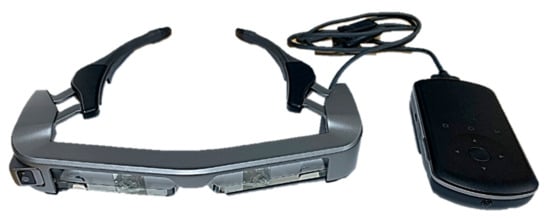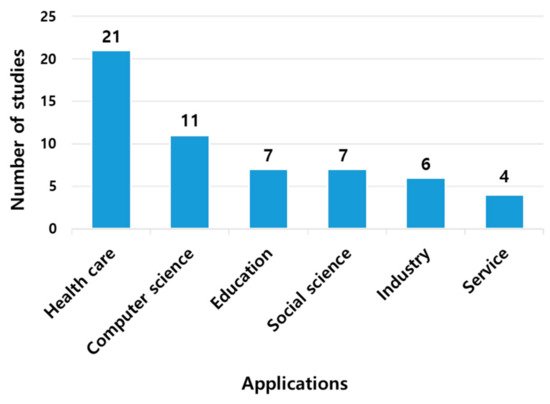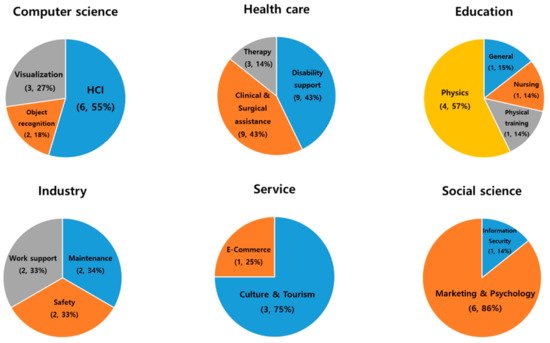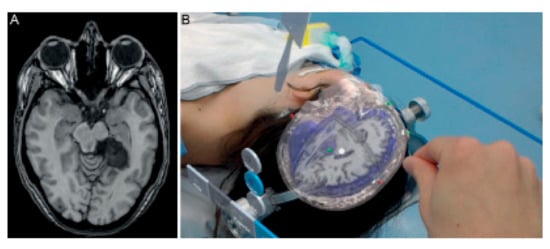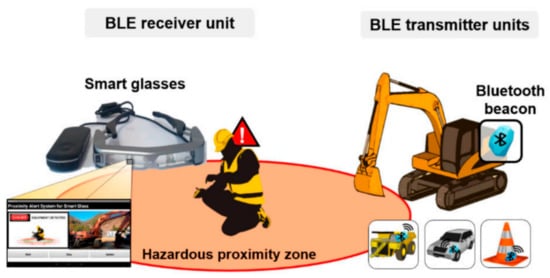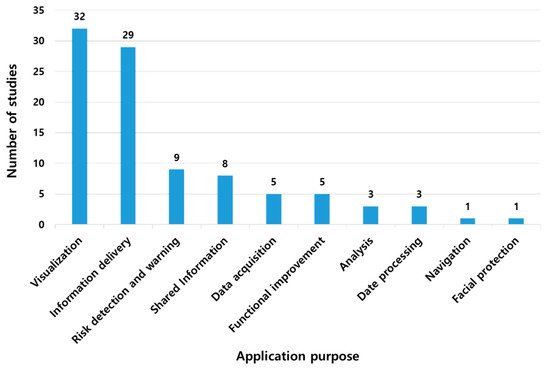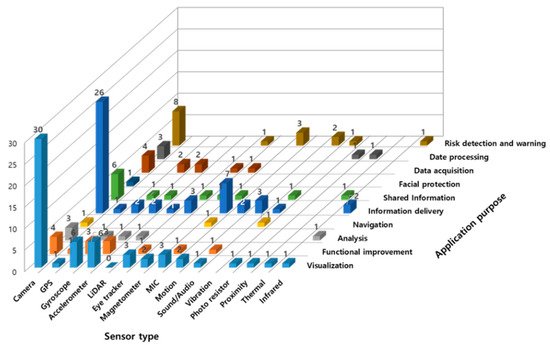2. Smart Glasses Research Trend
To analyze the areas in which smart glasses are actively researched, the 57 filtered studies were classified into 7 categories: computer science, healthcare, education, industry, service, social science, and agriculture. During the first stage, we classified them based on seven fields of application, and in the second stage, computer science was classified into human–computer interaction (HCI), object recognition, and visualization, and healthcare was classified into clinical and surgical assistance, disability support, and therapy. In addition, education was divided into nursing, physical training, and physics, and industry was divided into maintenance and safety. Service was divided into culture and tourism and e-commerce, and social science was divided into information security, marketing, and psychology. Finally, agriculture was further categorized as work support ().
Figure 2. Structure of applied research fields and subfields.
Of the 57 studies in the first category, 21 were healthcare-related studies, with 36% of the 7 areas being the most active. Computer science was included in 11 cases and social science in 7 cases. Industry had six studies, and service had four, which was the smallest number (). In the second stage, the subfields in which smart glasses were employed and the corresponding ratios were analyzed ().
Figure 3. Number of studies based on a study of the application fields.
Figure 4. Detailed distribution of smart glass applications.
The computer science field is developing HCI
[13][14][15][16][17][18] as an interaction technology between humans and computers; object recognition
[19][20], which is a technology that recognizes what the user sees, based on a camera; and visualization
[8][21][22] to visually show data to users (). There are several research cases in the field of visualization. Riedlinger et al.
[22] compared Google’s Tango tablet with Microsoft’s HoloLens smart glasses in the context of their visualization of building information modeling data. For 16 participants, tests were conducted to solve four tasks using two devices, and the evaluations of users, in terms of interior design visualization and visualization of the modeling data, were analyzed. As a result of the analysis, it was found that most users preferred tablets that can enable the sharing of one screen with multiple people. Although smart glasses provided additional hands-free functionality and stability, tablets had a more positive impression on users than smart glasses because of the lack of the feeling of being isolated in the virtual world. shows an augmented reality (AR) view of a space for socializing, which was completed for comparison between tablets and smart glasses. Among the subfields of computer science, HCI had the highest proportion of studies at 55%, followed by visualization at 27%, and object recognition at 18%. To improve the convenience and efficiency using a detailed classification, the research and development of technologies that facilitate interactions between smart glasses and users is actively being pursued, and in particular, it was judged that there is a high level of interest in research on various interactions between users and devices.
Figure 5. Location of user study: renovated office area with available building information modeling data regarding the building itself as well as the furniture.
Top, real furniture after the renovation;
bottom, augmented reality visualization during construction
[22].
Table 1. Summary of smart glass applications in the field of computer science.
| Sub-Field |
References |
Year |
Aim of Study |
HCI
(Human–Computer Interaction) |
Belkacem et al. [13] |
2019 |
Inputting text into smart glasses using touch fiber |
| Zhang et al. [14] |
2014 |
Exploring the user’s visual interest through smart glasses |
| Lee et al. [15] |
2019 |
Development of technology to enter text through fingertip detection technology in the air without using a keyboard |
| Lee et al. [16] |
2019 |
| Lee et al. [17] |
2020 |
| Lee et al. [18] |
2020 |
| Object recognition |
Park et al. [19] |
2020 |
Effective object detection and object segmentation verification through wearable AR technology based on deep learning technology |
| Chauhan et al. [20] |
2016 |
Verification of biometric accuracy of smart glasses |
| Visualization |
Parmparau [21] |
2020 |
Development of technology to visualize digital contents |
| Riedlinger et al. [22] |
2019 |
Visualization comparison of hands-free (smart glass) versus non-hands-free (tablet) devices |
| Aiordǎchioae et al. [8] |
2019 |
Data cloud formation through tags extracted from images recorded with cameras in smart glasses |
The field of healthcare is subdivided into clinical and surgical assistance
[7][23][24][25][26][27][28][29][30], the development of technologies to help medical institution workers using smart glasses, disability support technologies
[10][31][32][33][34][35][36][37][38] assisting physically and mentally handicapped people, and therapy
[39][40][41] that effectively supports the treatment of patients (). Among them, the following research cases are in the fields of clinical and surgical assistance. van Doormaal et al.
[24] evaluated the validity and accuracy of holographic neural navigation (HN) using AR smart glasses. They programmed a nerve-searching system and evaluated the accuracy and feasibility of using the system in an operating room. The conventional neuronavigation fiducial registration error (CN FRE) was measured in a plastic head model with points displayed, and HN and CN FRE were measured in three patients (). Although the accuracy of hologram navigation using commercially available smart glasses in the measurement results has not reached a clinically acceptable level, it is possible to improve the accuracy and overcome the problem, and it has been evaluated that AR nerve navigation has significant potential. Clinical and surgical assistance and disability support in the healthcare field were conducted in the same proportion (43%) in 9 of the 21 papers. In addition, three studies were conducted in the therapy field. Using the results of this analysis, smart glasses are evenly applied in the field of healthcare, and are stably assisting users; however, it is difficult to employ smart glasses in a direct evaluation, and, therefore, technological development is required.
Figure 6. (
A) MRI patient 1. Left-sided mesiotemporal epidermoid. (
B) Hologram patient 1 including MRI
[24].
Table 2. Summary of smart glass applications in the field of healthcare.
| Sub-Field |
References |
Year |
Aim of Study |
| Clinical and Surgical assistance |
Yong et al. [23] |
2020 |
Enhancing the learning experience for trainees practicing microsurgery techniques for science and surgery |
| van Doormaal et al. [24] |
2019 |
To determine feasibility and accuracy of holographic neuronavigation (HN) using AR smart glasses. |
| Salisbury et al. [25] |
2018 |
Objective measurement of concussion-related disorders through smart glasses |
| Maruyama et al. [26] |
2018 |
Assessing the accuracy of visualizing 3D graphics in neurosurgery surgery |
| Klueber et al. [27] |
2019 |
Multiple patient monitoring |
| García-Cruz et al. [28] |
2018 |
Potential evaluation of smart eyeglasses in urology |
| Ruminski et al. [29] |
2016 |
Data exchange between medical information systems |
| Salisbury et al. [7] |
2020 |
Verification of the AR system accuracy of smart glasses in percutaneous needle interventions surgery |
| Nag et al. [30] |
2020 |
Analysis of emotional awareness of autistic children |
| Disability support |
Rowe [31] |
2019 |
Assisting people with peripheral vision loss through a risk detection and tracking system |
| Meza-de-Luna et al. [32] |
2019 |
Supporting social interaction (conversation) of people with visual impairments |
| Schipor et al. [33] |
2020 |
Improved convenience for visually impaired users through voice command input and control |
| Chang et al. [34] |
2020 |
Development of a system to improve the safety of the visually impaired when using drugs |
| Lausegger et al. [35] |
2017 |
Visual aid for people with color blindness |
| Miller et al. [10] |
2017 |
To improve the understanding of lectures for the hearing impaired |
| Janssen et al. [36] |
2017 |
Validation of gait assist effect in Parkinson’s disease patients |
| Sandnes [37] |
2016 |
Investigating the features that people with low vision need in smart glasses |
| Ruminski et al. [38] |
2015 |
Identifying the potential use of smart glasses in medical activities |
| Therapy |
Machado et al. [39] |
2019 |
Assisting people with autism to acquire daily life skills |
| Liu et al. [40] |
2017 |
System application using smart glasses for coaching to improve autism disorder |
| Vahabzadeh et al. [41] |
2018 |
Socio-emotional and behavioral function treatment of autistic students by intervening using smart glasses |
The industry field includes technical research on maintenance
[42][43], safety
[11][44], and work support
[45][46] (). Among them, in the safety field, the following studies have been conducted: Beak et al.
[11] developed a smart glass-based wearable personal proximity warning system (PWS) for the safety of pedestrians at construction and mining sites. Smart glasses receive a signal transmitted by a Bluetooth beacon that is attached to a heavy machine or vehicle and that provides a visual warning to the wearer based on the signal strength (). Regardless of the direction the pedestrian is looking, all warnings are issued normally over a distance of 10 m or more. In addition, under the same conditions, a smartphone-based PWS or a smart glass-based PWS was used to evaluate the workload index of 10 subjects. Test results of mental, temporal, and physical stress were underestimated when using a smart glass-based PWS. The evaluation results showed that the use of PWS based on smart glasses can free both hands of pedestrians, improve work efficiency, and help enhance the safety of pedestrians at construction and mining sites. In addition to this study, in the field of safety, two studies were conducted on maintenance and work support. As a result of detailed analyses in the industry field, research has been conducted such that the two lenses are not biased in each of the three cases.
Figure 7. Conceptual view of the personal proximity warning system (PWS) comprising a Bluetooth low energy (BLE) receiver unit and BLE transmitter units
[11].
Table 3. Summary of smart glass applications in the industry field.
| Sub-Field |
References |
Year |
Aim of Study |
| Maintenance |
Wolfartsberger et al. [42] |
2020 |
Development of technology that can support maintenance work on the job site |
| Siltanen and Heinonen [43] |
2020 |
| Safety |
Chang et al. [44] |
2018 |
Design and implementation of drowsiness fatigue monitoring system to improve road safety |
| Baek and Choi [11] |
2020 |
Development of smart glass-based proximity warning system for pedestrians at a mining site |
| Work support |
Kirks et al. [45] |
2019 |
Development of distributed control system based on smart glasses |
| Gensterblum [46] |
2020 |
Examine the possibility that commercial drones and smart glasses are disruptive technologies in the construction industry. |
The service category was divided into culture and tourism
[9][47][48], which enhances the understanding of artwork using a vivid expression method applying smart glasses, and the e-commerce field
[49] for the purchasing of products through the internet or PC communication (). Research has also been conducted on museum visitors in the fields of culture and tourism. To explore the use of smart glasses in museums, Marco et al.
[48] designed a glassware prototype that can provide visitors with a new interpretation experience in museums. The effects were tested through field experiments. They designed and implemented a glassware prototype and tested the interaction between glasses and users based on 12 visitors of the robot gallery at the MIT Museum. Participants were observed and interviewed during the experiment. As a result of an analysis based on qualitative research data collected through interviews, it became clear that the use of smart glasses makes it possible to better appreciate art. In this manner, the culture and tourism field accounted for 75% of the research corresponding to the service field; however, it was judged that research on smart glasses in the e-commerce-related service field is still inactive compared to that in the culture and tourism field, owing to security issues.
Table 4. Summary of smart glass applications in the service field.
| Sub-Field |
References |
Year |
Aim of Study |
| Culture and Tourism |
Han et al. [9] |
2019 |
Providing a framework for adopting smart glasses in cultural tourism |
| tom Dieck et al. [47] |
2015 |
Improving the understanding of art and analyzing the effects of using smart glasses in museums |
| Mason [48] |
2016 |
| E-Commerce |
Ho et al. [49] |
2018 |
Ticketing without input after automatically recognizing the license plate using smart glasses |
The education section was divided into nursing
[50] for the education of medical workers using AR; physical training
[51], such as cycling training; and a general category
[52] for future informatization in experimental education and physics
[53][54][55][56] to effectively teach physical theories using visual methods (). Research has been conducted in the field of physics. Strzys et al.
[56] conducted experiments to improve the understanding of physical concepts by directly showing invisible physical quantities through AR-based learning (). In a metal heat conduction experiment with 59 subjects, the temperature of the object was visualized in color in an AR form directly on the actual object itself. As a result of a questionnaire survey, it was found that MR improved learners’ understanding of basic physics concepts. Therefore, we determined that complex experiments can be easily understood through AR, using detailed analysis results in the field of education. Regarding the remaining fields, four among the seven studies corresponded to the physics field. The visual representation of physical phenomena that cannot be observed was judged to be the most useful for learning physics using smart glasses.
Figure 8. Experimental setup (rod with PVC insulation) and user wearing a HoloLens
[56].
Table 5. Summary of smart glass applications in the field of education.
| Sub-Field |
References |
Year |
Aim of Study |
| Nursing |
Kopetz et al. [50] |
2019 |
User-oriented development of smart glasses for nursing education boarding training |
| Physical training |
Berkemeier et al. [51] |
2018 |
Consumer perception survey for application to cycling training |
| General |
Cao et al. [52] |
2019 |
Development of new augmented reality learning system for future informatization experiment |
| Physics |
Spitzer et al. [53] |
2018 |
Distance learning and support using smart glasses |
| Kapp et al. [54] |
2018 |
Enhance understanding of physics experiments through smart glasses |
| Thees et al. [55] |
2020 |
| Strzys et al. [56] |
2018 |
In social science, a study was conducted on user information security associated with the use of smart glasses
[57]. A marketing and psychology study was conducted to analyze the factors that influence consumers’ social perception of smart glasses and device selection
[58][59][60][61][62][63]. In the field of social sciences (), six studies (86% of the seven papers) focused on marketing and psychology. It was found that the consumer recognition of smart eyeglasses is increasing with progress in the commercialization of smart eyeglasses.
Table 6. Summary of smart glass applications in the field of social science.
| Sub-Field |
References |
Year |
Aim of Study |
| Information security |
Rauschnabel et al. [57] |
2018 |
Research on consumer perception of smart glasses and personal information risk |
| Marketing and Psychology |
Adapa et al. [58] |
2018 |
Investigating factors influencing the selection of smart wearable devices |
| Rauschnabel et al. [59] |
2015 |
| Rauschnabel et al. [60] |
2016 |
Consumer perception of smart glasses as a fashion |
| Rallapalli et al. [61] |
2014 |
Physical analysis of (indoor) retail stores using smart glasses |
| Hoogsteen et al. [62] |
2020 |
Recognition of smart glasses by low-visibility persons |
| Ok et al. [63] |
2015 |
Analysis of harmfulness and social perception in purchasing smart glasses |
In the field of agriculture, research has been conducted to improve the performance of livestock farming operations
[64]. Caria et al.
[64] conducted experiments on knowledge-based extensions on how smart glasses interact with the agricultural environment. Sixteen participants conducted a test in milking parlors to read, identify, and group various types of content through smart glasses (). A questionnaire was administered to evaluate the amount of work performed by the device and its ease of use. It was found that smart glasses provided a positive opportunity for livestock management in terms of animal data consultation and information evaluation. Smart glasses can help improve human cognition and usefulness in agricultural fields. It seems that only a few studies have been conducted in this regard. Therefore, it was determined that relatively active research must be conducted when compared to that in other fields.
Figure 9. (
a) Sheep information in text and graphic format and (
b) a participant reading information regarding an animal on GlassUp F4 smart glasses (F4SG) while milking
[64].
3. Sensors Depending on the Application Purpose
In this study, smart glasses were found to be used in various fields, although the purpose of their application may be different. Smart glasses have been used for one or more purposes. Therefore, the research was categorized based on the purpose of using the smart glasses, excluding the fields of use (). Because smart glasses play the most visual role, most research aims to convey other information to the user’s line of sight. Therefore, 32 studies were performed to convey the information obtained from smart glasses and then to visualize such information. Visualization and information transmission corresponded to 32 and 29 studies, respectively, accounting for 65% of the total utilization purpose. In addition, nine studies were aimed at notifying users of dangers using acquired data and eight studies were aimed at sharing information.
Figure 10. Number of studies based on research purpose.
In this study, various sensors built into smart glasses were utilized based on the research aim. Therefore, the sensors used in the research were classified, and the types of sensors applied the most were analyzed. shows the frequency of the sensors used as a percentage. More than half of the studies (45) used camera sensors that are the most suitable for the original role of smart glasses. Smart glasses have a disadvantage in that data entry is inconvenient because there is no input device, such as a keyboard. Therefore, a microphone was used in eight of the studies to solve the input problem. The sensors needed to calculate motion (gyroscope, accelerometer, GPS, and motion) were also used. In addition, sound/audio and vibration sensors were used for information transmission through sound and vibration.
Figure 11. Frequency and ratio of each sensor used in the study.
The use of arbitrary sensors was categorized based on the aim of use (). As the classification results show, a camera was used for all research purposes. Among the 32 studies aimed at visualization and information transmission, 30 used camera sensors. Among the studies investigated in this study, those aimed at visualization utilized sensors the most, such as gyroscopes, accelerometers, eye trackers, and microphones, compared to studies conducted for other purposes. In addition, 36 studies, excluding 3 out of the 39, aimed at information transmission used camera sensors to obtain and transmit information, and multiple sensors, such as a GPS, motion sensor, and infrared device, were used.
Figure 12. Use of sensors according to the purpose of using smart glasses.

